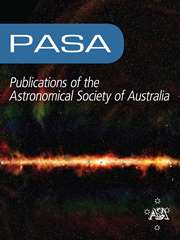No CrossRef data available.
Article contents
High-time-resolution properties of 35 fast radio bursts detected by the Commensal Real-time ASKAP Fast Transients survey
Published online by Cambridge University Press: 01 October 2025
Abstract
We present microsecond-resolution, coherently-dedispersed, polarimetric measurements of 35 fast radio bursts (FRBs) detected during the Commensal Real-time ASKAP Fast Transients (CRAFT) incoherent sum (ICS) survey with the Australian Square Kilometre Array Pathfinder (ASKAP). We find a wide diversity of time–frequency morphology and polarisation properties broadly consistent with those of currently known non-repeating FRBs. The high S/N and fine time-resolution of our data however reveals a wealth of new information. Key results include (i) the distribution of scattering timescales, τobs, is limited purely by instrumental effects, with no downturn at high τobs as expected from a log-normal distribution; (ii) for the 29 FRBs with known redshift, there is no detectable correlation between τobs and dispersion measure (DM) fluctuations about the Macquart relation, in contrast to expectations from pulsar scattering-DM relations; (iii) all FRBs probably have multiple components, and at least a large fraction have variable PA, the identification of which is limited by scattering; (iv) at least half of all FRBs exhibit PA microstructure at 200 µs–200 ns timescales, with behaviour most closely resembling a sub-category of Crab main pulses; (v) that there is a break in the FRB circular polarisation distribution at Stokes V ≳ 20%, which is suggestive of a discrete sub-population.
Keywords
Information
- Type
- Research Article
- Information
- Creative Commons
- This is an Open Access article, distributed under the terms of the Creative Commons Attribution licence (https://creativecommons.org/licenses/by/4.0/), which permits unrestricted re-use, distribution and reproduction, provided the original article is properly cited.
- Copyright
- © The Author(s), 2025. Published by Cambridge University Press on behalf of Astronomical Society of Australia

